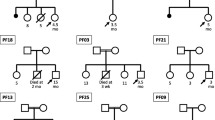Abstract
Benign recurrent intrahepatic cholestasis (BRIC) is an autosomal recessive liver disease characterized by multiple episodes of cholestasis without progression to chronic liver disease. The gene was previously assigned to chromosome 18q21, using a shared segment analysis in three families from the Netherlands. In the present study we report the linkage analysis of an expanded sample of 14 BRIC families, using 15 microsatellite markers from the 18q21 region. Obligate recombinants in two families place the gene in a 7-cM interval, between markers D18S69 and D18S64. All intervening markers had significant LOD scores in two-point linkage analysis. Moreover, we identified one family in which the BRIC gene seems to be unlinked to the 18q21 region, or that represents incomplete penetrance of the BRIC genotype.
Similar content being viewed by others
Author information
Authors and Affiliations
Additional information
Received: 6 March 1997 / Accepted: 26 March 1997
Rights and permissions
About this article
Cite this article
Sinke, R., Carlton, V., Juijn, J. et al. Benign recurrent intrahepatic cholestasis (BRIC): evidence of genetic heterogeneity and delimitation of the BRIC locus to a 7-cM interval between D18S69 and D18S64. Hum Genet 100, 382–387 (1997). https://doi.org/10.1007/s004390050520
Issue Date:
DOI: https://doi.org/10.1007/s004390050520




